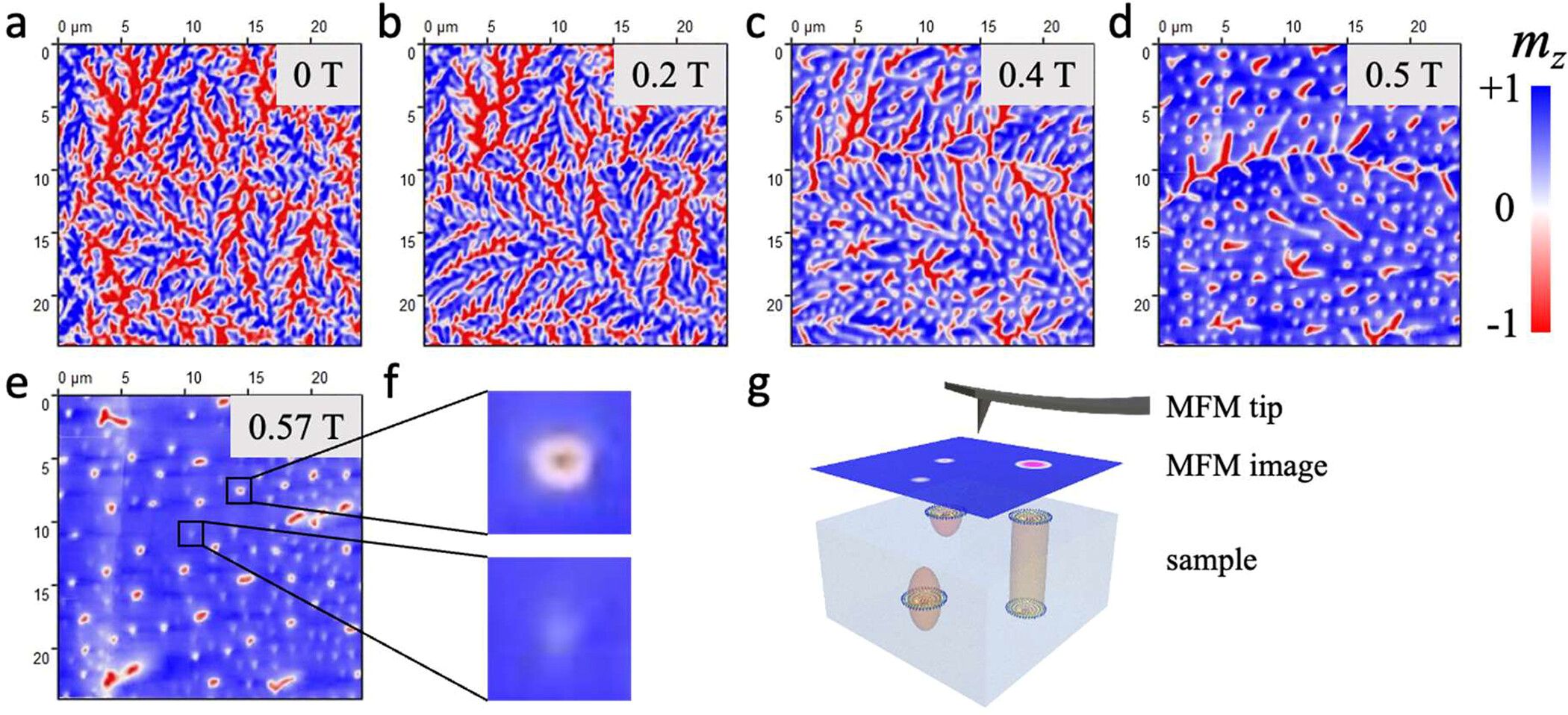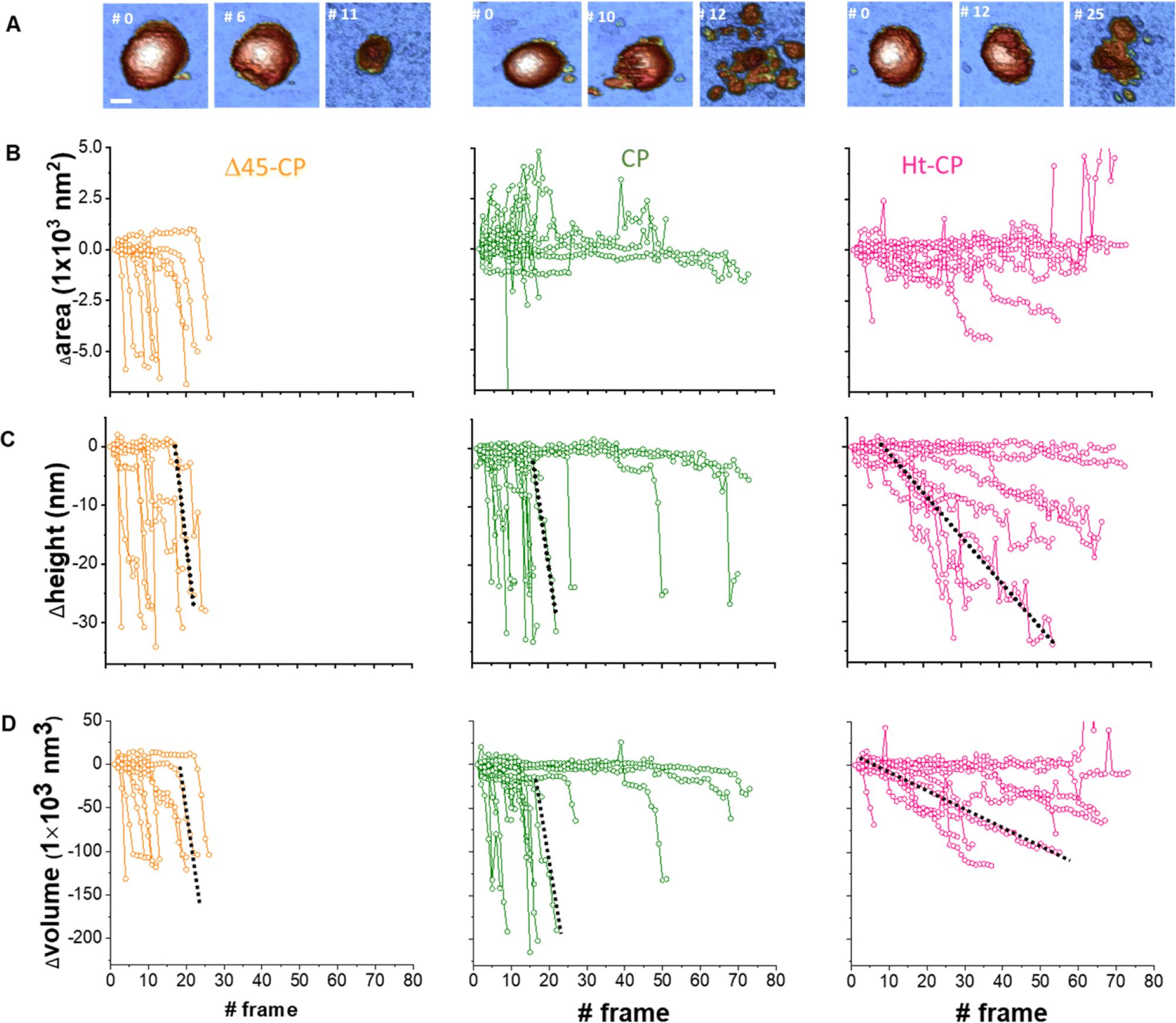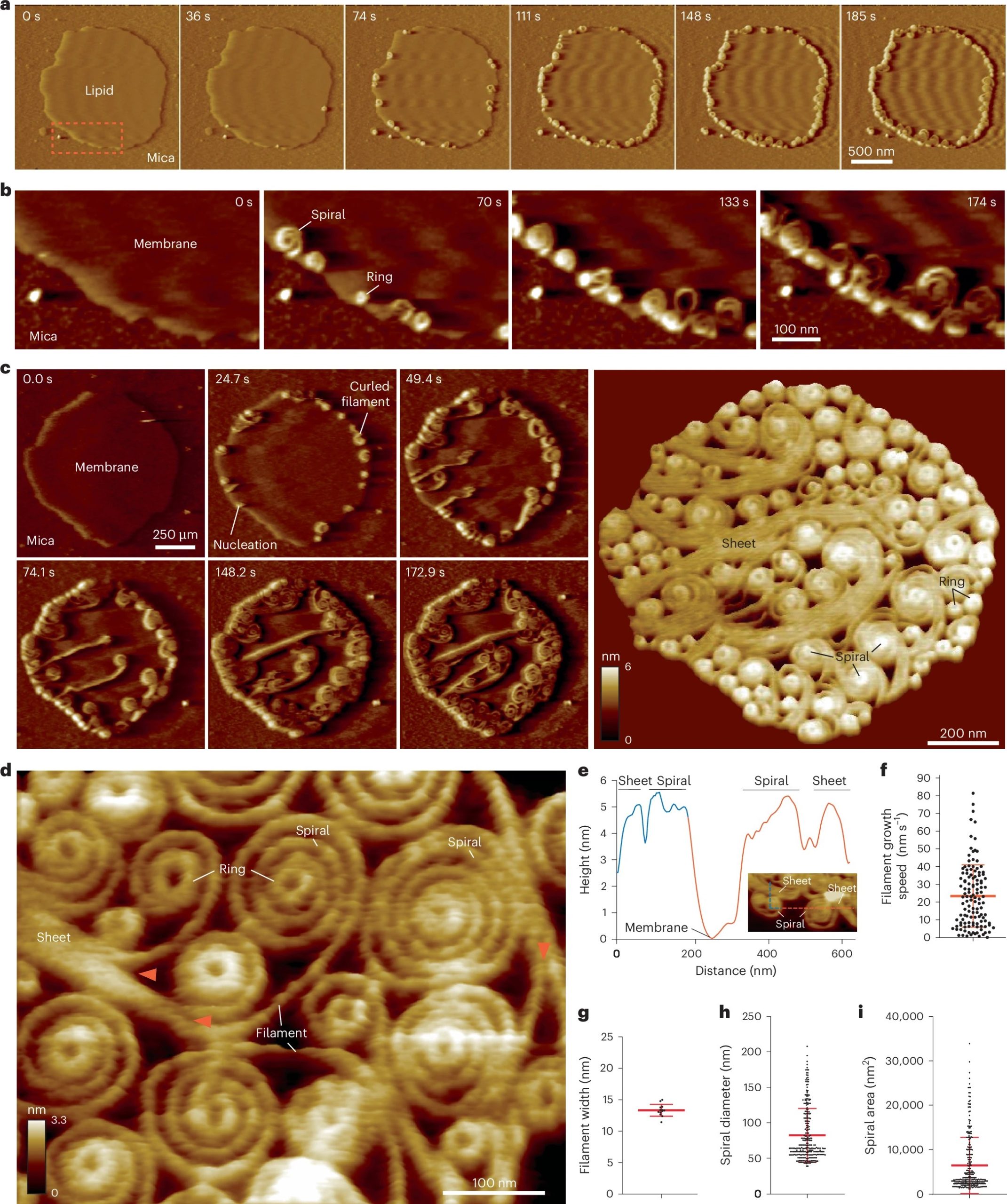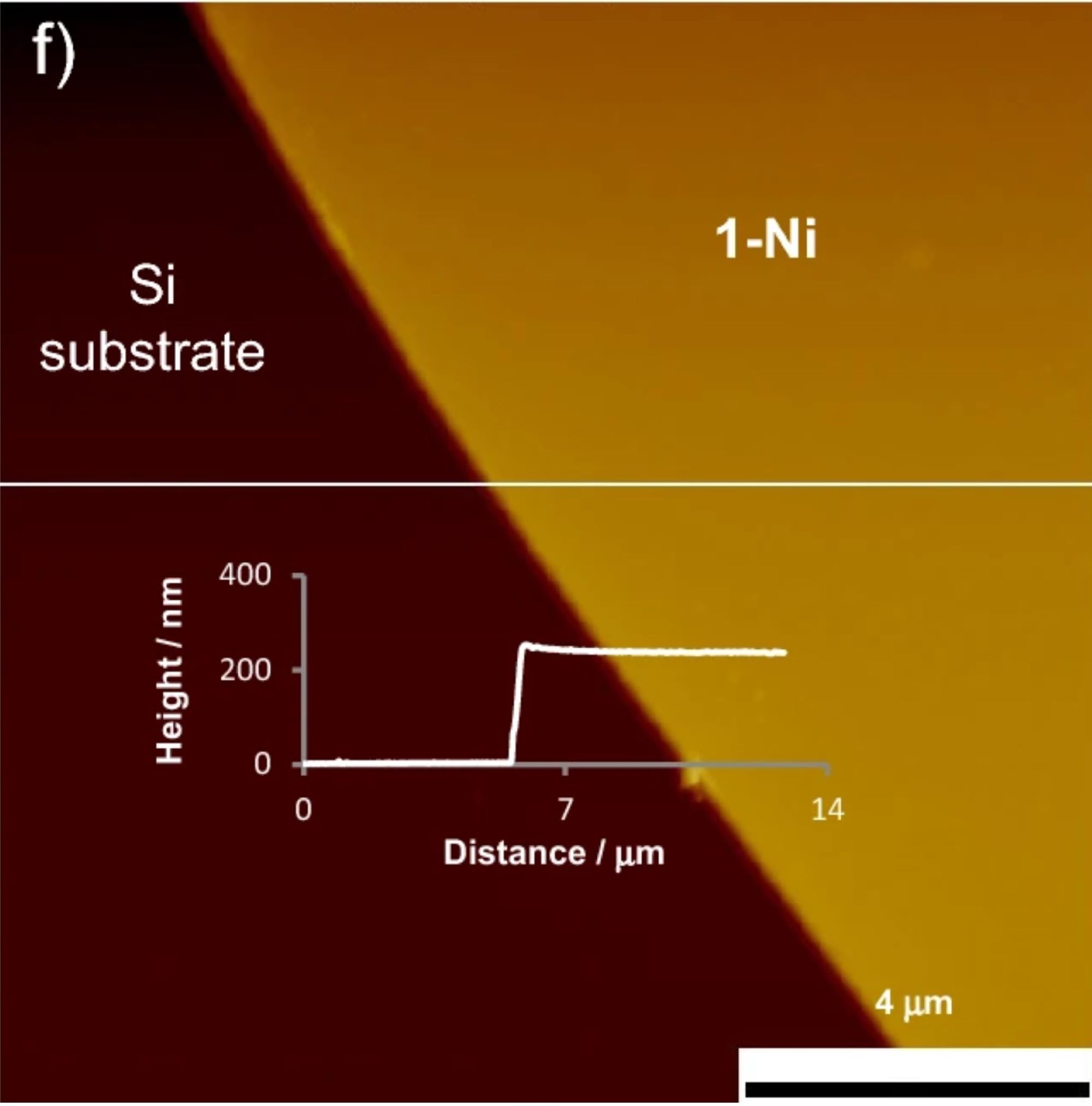

High-Speed Three-Dimensional Scanning Force Microscopy Visualization of Subnanoscale Hydration Structures on Dissolving Calcite Step EdgesMon Mar 17 2025
NanoWorld Ultra-Short Cantilevers USC-F5-k30 https://www.nanoworld.com/Ultra-Short-Cantilevers-USC-F5-k30 for #highspeedatomicforcemicroscopy were used for the high-speed #ThreeDimensionalScanningForceMicroscopy ( #3DSFM ) imaging at 1.5 s/3D image while maintaining F min of 25 pN described in this article:
Kazuki Miyata, Kosuke Adachi, Naoyuki Miyashita, Keisuke Miyazawa, Adam S. Foster and Takeshi Fukuma
High-Speed Three-Dimensional Scanning Force Microscopy Visualization of Subnanoscale Hydration Structures on Dissolving Calcite Step Edges
Nano Letters 2024, 24, 35, 10842–10849


Poroelastic and viscoelastic properties of soft materials determined from AFM force relaxation and force-distance curvesMon Mar 17 2025
AFM force relaxation and force-distance curves with sQube colloidal AFM probes help study the poroelastic and viscoelastic properties of soft matter.
“The AFM-based methodology described herein provides a solid framework to draw up a complete characterization of the time-dependent mechanical properties of living matter. Due to the structural complexity of cells and tissues, understanding their energy dissipation mechanisms (related to the experimental conditions) is an essential prerequisite toward quantitative determination of their mechanical responses, by analyzing experimental data with the appropriate theoretical models.”


Congratulations to MikroMasch® on the launch of their latest innovation—the SelfAdjust-Air AFM probes!Fri Mar 14 2025
We are proud to announce our brand new SelfAdjust-Air AFM probes.
The SelfAdjust-Air AFM probes are specifically designed for Bruker's ScanAsyst®* mode. The AFM cantilever properties, including the force constant and the Q-factor, optimally support the ScanAsyst®* self-optimization algorithm.
The SelfAdjust-Air are available to order now!
* ScanAsyst® is a trademark of Bruker Corporation


Magnesium Transfer between Atomic Force Microscopy Probes and Metal Electrodes in Aqueous Alginate ElectrolytesThu Mar 13 2025
@NANOSENSORS diamond coated PointProbe® Plus AFM probes CDT-NCHR https://www.nanosensors.com/conductive-diamond-coated-tip… were used for the deposition experiments with an #AFMprobe as an electrode described in this article.
@NANOSENSORS PointProbe® Plus PPP-NCHR #AFMprobes https://www.nanosensors.com/pointprobe-plus-non-contact… were used to examine the deposition results on the on the substrates.
Walter J. Legerstee, Lindah Kiriinya, Mark Kwakernaak and Erik M. Kelder
Magnesium Transfer between Atomic Force Microscopy Probes and Metal Electrodes in Aqueous Alginate Electrolytes
Polymers 2024, 16(12), 1615


50 probes without having to order 50 identical AFM probes - BudgetComboBox from BudgetSensors®Tue Mar 11 2025
Our unique product BudgetComboBox allows you to compile a selection of different AFM probes of your choosing.
With the BudgetComboBox you take advantage of our built-in volume discounts for boxes of 50 probes without having to order 50 identical AFM probes.


Human muscle stem cell responses to mechanical stress into tunable 3D alginate matricesWed Mar 05 2025
Our colloidal probes with glass microspheres support research on human muscle stem cell encapsulation in hydrogels, helping develop higher efficiency muscle regeneration protocols to treat muscle injury.


World Engineering Day for Sustainable Development 2025Tue Mar 04 2025
Happy World Engineering Day for Sustainable Development 2025!
“Engineering has always had an essential role in development and human welfare. Ensuring that future generations of engineers and scientists will be able to design solutions for local and global challenges is critical.
UNESCO's General Conference proclaimed the 4 March World Engineering Day for Sustainable Development during its 40th session in November 2019 (40 C/64), to raise awareness of the role of engineering in modern life, which is essential to mitigate the impact of climate change and advance sustainable development, especially in Africa and the small island developing states (SIDS).”


Nanoscale resolved mapping of the dipole emission of hBN color centers with a scattering-type scanning near-field optical microscopeMon Mar 03 2025
#Colorcenters in #hexagonalboronnitride ( #hBN) are promising candidates as #quantumlightsources for future technologies. *
In the article “Nanoscale resolved mapping of the dipole emission of hBN color centers with a scattering-type scanning near-field optical microscope “, Iris Nihues, Daniel Wigger, Korbinian Kaltenecker, Annika Klein-Hitpass , Philippe Roelli, Aleksandra K. Dąbrowska, Katarzyna Ludwiczak, Piotr Tatarczak , Janne O. Becker , Robert Schmidt, Martin Schnell, Johannes Binder, Andrzej Wysmołek and Rainer Hillenbrand utilize a #scatteringtypeNearfieldOpticalMicroscope ( #sSNOM ) to study the #photoluminescence (PL) emission characteristics of such #quantumemitters in metalorganic vapor phase epitaxy grown hBN. *
On the one hand, Iris Niehues et al. demonstrate direct near-field optical excitation and emission through interaction with the #nanofocus of the #AFMtip resulting in a subdiffraction limited tip-enhanced PL hotspot. *
On the other hand, the authors show that indirect excitation and emission via scattering from the AFM tip significantly increases the recorded PL intensity. This demonstrates that the tip-assisted PL (TAPL) process efficiently guides the generated light to the detector.
Iris Niehues et al. apply the TAPL method to map the in-plane dipole orientations of the hBN color centers on the nanoscale. This work promotes the widely available s-SNOM approach to applications in the quantum domain including characterization and optical control.
The investigation utilizes a scattering-type near-field optical microscope employing a metallized Arrow AFM tip ( NanoWorld Arrow-NCPt #AFMprobehttps://www.nanoworld.com/tapping-mode-platinum-coated-afm-tip-arrow-ncpt ) illuminated by monochromatic laser light.
The AFM tip acts as an #opticalantenna, transforming the incident p-polarizedlight into a highly focused near field at the AFM tip apex, the so-called #nanofocus.
The nanofocus interacts with the sample leading to modified scattering from the AFM tip and encoding local sample properties.
In conventional s-SNOM operation, the elastically scattered light is recorded as function of sample position (note that the sample is scanned), yielding near-field optical images with a spatial resolution down to 10 nm.
To supress background scattering, the AFM is operated in tapping mode and the detector signal is demodulated at a higher harmonic of the AFM tip's oscillation frequency.
Please have a look at the NanoWorld blog for the full citation and a direct link to the full article https://www.nanoworld.com/…/nanoscale-resolved-mapping-of…/


NanoAndMore Japan will be exhibiting at the 72nd Japan Society of Applied Physics Spring Academic Conference and Exhibition JSAP EXPO Spring 2025Fri Feb 28 2025
NanoAndMore Japan will be exhibiting at the 72nd Japan Society of #AppliedPhysics Spring Academic Conference and Exhibition
JSAP EXPO Spring 2025
A representative will be at the booth, so please feel free to contact us with any questions.
Please visit us at our booth to learn all about the #AFMprobes we offer: NanoWorld , NANOSENSORS , Olympus Corporation, nanotools ,BudgetSensoMikroMasch and sQube Colloidal AFM Probes are all available from us.
Date and time:
March 14th (Friday) to 16th (Sunday), 2025 9:30-18:00
March 17th (Monday) 9:30-12:00
Location: Tokyo University of Science Noda Campus Morito Memorial Gymnasium


Thickness-Tunable Zoology of Magnetic Spin Txtures Observed in Fe5GeTe2Thu Feb 27 2025
The family of two-dimensional (2D) van der Waals (vdW) materials provides a playground for tuning structural and magnetic interactions to create a wide variety of spin textures. *
Of particular interest is the ferromagnetic compound #Fe5GeTe2 that Ajesh K. Gopi et al. show displays a range of complex spin textures as well as complex crystal structures. *
In the article “Thickness-Tunable Zoology of Magnetic Spin Textures Observed in Fe5GeTe2”, using a high-brilliance laboratory X-ray source, Ajesh K. Gopi, Abhay K. Srivastava, Ankit K. Sharma, Anirban Chakraborty, Souvik Das, Hakan Deniz, Arthur Ernst, Binoy K. Hazra, Holger L. Meyerheim and Stuart S.P. Parkin show that the majority (1 × 1) Fe5GeTe2 (FGT5) phase exhibits a structure that was previously considered as being centrosymmetric but rather lacks inversion symmetry. *
In addition, FGT5 exhibits a minority phase that exhibits a long-range ordered (√3 × √3)-R30° superstructure. This superstructure is highly interesting in that it is innately 2D without any lattice periodicity perpendicular to the vdW layers, and furthermore, the superstructure is a result of ordered Te vacancies in one of the topmost layers of the FGT5 sheets rather than being a result of vertical Fe ordering as earlier suggested. *
Ajesh K. Gopi et al. show, from direct real-space magnetic imaging, evidence for three distinct magnetic ground states in lamellae of FGT5 that are stabilized with increasing lamella thickness, namely, a multidomain state, a stripe phase, and an unusual fractal state.*
In the stripe phase the authors also observe unconventional type-I and type-II bubbles where the spin texture in the central region of the bubbles is nonuniform, unlike conventional bubbles.
In addition, they find a #bobber or a cocoon-like spin texture in thick (∼170 μm) FGT5 that emerges from the fractal state in the presence of a magnetic field.
Among all the #2DvdW magnets Ajesh K. Gopi et al. have thus demonstrated that FGT5 hosts perhaps the richest variety of magnetic phases that, thereby, make it a highly interesting platform for the subtle tuning of magnetic interactions.
#MagneticForceMicroscopy ( #MFM) measurements were performed in a commercially available variable-temperature #magneticforcemicroscope equipped with a vector superconducting magnet.
NANOSENSORS SSS-MFMR https://www.nanosensors.com/supersharpsilicon-magnetic…, a magnetic #AFMprobe with an #AFMtip radius of curvature < 15 nm was used for all MFM measurements.
Please have a look at the NANOSENSORS blog for the full citation and a direct link to the full article


Visit us at NanoAndMore USA booth no. 408 at the Biophysical Society meeting 2025Fri Feb 14 2025
Durable and conductive interfaces that enable chronic and high-resolution recording of neural activity are essential for understanding and treating #neurodegenerativedisorders. These #chronicimplants require long-term stability and small contact areas. Consequently, they are often coated with a blend of conductive #polymers and are crosslinked to enhance durability despite the potentially deleterious effect of crosslinking on the mechanical and electrical properties.
In the article “Surface-Grafted Biocompatible Polymer Conductors for Stable and Compliant Electrodes for Brain Interfaces” by Rachel Blau, Samantha M. Russman, Yi Qie, Wade Shipley, Allison Lim, Alexander X. Chen, Audithya Nyayachavadi, Louis Ah, Abdulhameed Abdal, Guillermo L. Esparza, Samuel J. Edmunds, Ritwik Vatsyayan, Sean P. Dunfield, Moumita Halder, Jesse V. Jokerst, David P. Fenning, Andrea R. Tao, Shadi A. Dayeh and Darren J. Lipomi (2024) https://advanced.onlinelibrary.wiley.com/…/adhm.202402215
Describe the grafting of the poly(3,4 ethylenedioxythiophene) scaffold, poly(styrenesulfonate)-b-poly(poly(ethylene glycol) methyl ether methacrylate #blockcopolymerbrush to gold, in a controlled and tunable manner, by surface-initiated atom-transfer radical polymerization (SI-ATRP). This “#blockbrush ” provides high volumetric capacitance (120 F cm─3), strong adhesion to the metal (4 h ultrasonication), improved surface hydrophilicity, and stability against 10 000 charge–discharge voltage sweeps on a multiarray neural electrode. In addition, the block-brush film showed 33% improved stability against current pulsing. This approach can open numerous avenues for exploring specialized polymer brushes for bioelectronics research and application.
The following #AFMprobes offered by NanoAndMore were used for the #AFMcharacterization described in the article:
The #topographical imaging was done with MikroMasch Opus 160AC NA #AFMtips for #tappingmode in air https://www.nanoandmore.com/AFM-Tip-160AC-NA and NANOSENSORS uniqprobe qp-BioAC #AFMtips https://www.nanoandmore.com/AFM-Probe-qp-BioAC for #liquidimaging in DI water.
The #mechanicalmeasurements were conducted in DI water with nanotools Biosphere B500-CONT #AFMtips https://www.nanoandmore.com/AFM-Probe-biosphere-B500-CONT and #indentationcurves were fit to the Dimitriadis model using custom MATLAB scripts.
The thickness of the brush for the model fitting was found by scraping away an area of brush in air with a MikroMasch HQ:NSC14/Hard/Al BS #AFMtip https://www.nanoandmore.com/AFM-Probe-hq-nsc14-hard-al-bs , leaving behind the bare gold substrate, washing, and measuring the height of the neighboring brushes in tapping mode after equilibration in water for 1 h.
Want to find out more about these #AFMcantilevers? Then visit us at NanoAndMore USA booth no. 408 at the @@Biophysical Society meeting 2025 #bps in Los Angeles from February 16-18, 2025 https://www.biophysics.org/2025meeting


Mechanical disassembly of human picobirnavirus like particles indicates that cargo retention is tuned by the RNA-coat protein interactionWed Feb 12 2025
The idea of using #viruslikeparticles as #nanocarriers for #heterologouscargotransport and delivery requires controlling the stability of the container–cargo system. *
In particular, the conditions of the cargo delivery entail tailoring the escape of the molecular payload when the #virusparticle is disassembled. What happens to the internalized molecules when the #nanocage is opened? *
To this end, it is necessary to control the cargo–container interaction which, in turn, would tune the retention of cargo when the disassembly of the #nanocarrier takes place. Thus, it is necessary to develop nanocarrier systems that facilitate the control of the cargo retention conditions as a function of its interaction with the #nanocontainer. *
In the article “Mechanical disassembly of human picobirnavirus like particles indicates that cargo retention is tuned by the RNA–coat protein interaction” María J. Rodríguez-Espinosa, Javier M. Rodríguez, José R. Castón and Pedro J. de Pablo describe how they designed three mutants of human #picobirnavirus where the #RNA–coat protein interaction, observed previously via cryo-electron microscopy, is modified by changing the N-terminal end of the coat protein.
The authors used #atomicforcemicroscopy ( #AFM) for inducing the mechanical unpacking of the #RNA internalized in particles of each mutant. *
Their experiments crack-opened individual particles in real time to monitor the cargo release. Among other results, María J. Rodríguez-Espinosa et al. have measured that an increment in the N-terminal length by just 8% increases the cargo retention of partially disrupted particles by a factor of 10 with respect to the wild type. *
For #mechanicalfatigue experiments, rectangular #AFMcantilevers ( NANOSENSORS™, uniqprobe qp-BioAC #AFMprobes with three different AFM cantilevers per chip) with nominal spring constants of 0.05 and 0.1 N m−1 were used. https://www.nanosensors.com/uniqprobe-uniform-quality…
Please visit the NANOSENSORS blog for the full citation and a direct link to the full article.


Non-contact AFM probes Tap300Al-G and geckosMon Feb 10 2025
What do geckos and our non-contact AFM probes Tap300Al-G have in common? They both take advantage of van der Waals forces. For a refresher on these weak intermolecular forces, check here:
For a refresher on our bestselling Tap300Al-G, in case you need one, check here:


Mechanism for Vipp 1 spiral formation, ring biogenesis, and membrane repairFri Feb 07 2025
The ESCRT-III-like protein #Vipp1 couples filament polymerization with #membraneremodeling. It assembles planar sheets as well as 3D rings and helical polymers, all implicated in mitigating plastid-associated membrane stress. The architecture of Vipp1 planar sheets and helical polymers remains unknown, as do the geometric changes required to transition between polymeric forms. *
In the article “Mechanism for Vipp1 spiral formation, ring biogenesis, and membrane repair” Souvik Naskar et al. (2024) show how cyanobacterial Vipp1 assembles into morphologically-related sheets and spirals on #membranes in vitro.*
The spirals converge to form a central ring similar to those described in membrane budding. Cryo-EM structures of helical filaments reveal a close geometric relationship between Vipp1 helical and planar lattices. Moreover, the helical structures reveal how filaments twist—a process required for Vipp1, and likely other #ESCRTIII filaments, to transition between planar and 3D architectures. *
Overall, the authors’ results provide a molecular model for Vipp1 ring biogenesis and a mechanism for Vipp1 #membranestabilization and repair, with implications for other ESCRT-III systems. *
NanoWorld Ultra-Short Cantilevers USC-F0.3-k0.3 https://www.nanoworld.com/Ultra-Short-Cantilevers-USC-F0.3… for #HighSpeedAFM ( #HSAFM) with a typical spring constant of 0.3 N nm−1 and a typical resonance frequency of about 300 kHz were used for image acquisition with fast scanning #atomicforcemicroscopy.*
Please have a look at the NanoWorld blog for the full citation and a direct link to the full article.


sQube large-diameter microspheres available on soft cantilevers of the “qp” series by NANOSENSORS™Sat Feb 01 2025
We are happy to announce that all our large-diameter microspheres are now available on the soft, quartz-like AFM cantilevers of the “qp” series by NANOSENSORS™. Check out our catalog to see our expanded product line!


Happy Spring Festival 2025Wed Jan 29 2025
We would like to thank all users of our #AFMprobes, our partners and clients worldwide for their trusting cooperation in the last year and are looking forward to another year with you.
May the new #yearofthesnake bring happiness, health, opportunities for growth and success to all of you!


Happy New Lunar Year of the SnakeWed Jan 29 2025
We wish everyone a good start into the new lunar year of the snake.


NanoAndMore GmbH is thrilled to announce its participation at the XXIV. Linz Winter WorkshopTue Jan 28 2025
NanoAndMore GmbH is thrilled to announce its participation at the XXIV. Linz Winter Workshop, an exceptional gathering focused on advancing biological #singlemoleculeresearch, #nanoscience, #nanomedicine, #cellscience, and #bionanotechnology.
NanoAndMore Europe #AFMprobes store https://www.nanoandmore.com/eu/ is a proud sponsor of this workshop which is a hub for innovation of force and optical microscopy/spectroscopy techniques. We’re especially excited about this year’s special sessions on nano-medicine and #highspeedatomicforcemicroscopy ( #HSAFM).
For more information on the workshop have a look at the @jkulinz Linz University Institute for Biophysics webpage: https://www.jku.at/ins…/veranstaltungen/linz-winterworkshop/
Stay tuned for insights and highlights and meet us at our booth as we join this inspiring community of researchers and pioneers.
Event Dates: Jan. 31st - Feb. 3rd, 2025
Location: Johannes Kepler University (JKU), Linz, Austria


Calibration of atomic force microscope cantileversFri Jan 24 2025
Investigation of the experimental parameters of the Sader Method formula for calculating the force constants of AFM cantilevers using micro Laser Doppler Velocimetry and MikroMasch HQ:NSC14/Al BS AFM probes


A Bis(terpyridine)nickel(II)-Based Coordination Nanosheet: A Redox-Active Materials with Flexibility and TransparencyTue Jan 21 2025
Coordination nanosheets (CONASHs) are bottom-up-type, two-dimensional polymers woven through coordination reactions of molecular, ionic, or atomic components. *
Due to the diversity of their chemical and physical properties arising from an infinite variety of ligand and metal ions, CONASHs have attracted considerable attention. Functional CONASHs tethering 1,2-dithiolate and its analogues, carboxylate, dipyrromethine, and polypyridyl ligands have been developed. *
In the article “A Bis(terpyridine)nickel(II)-Based Coordination Nanosheet: A Redox-Active Material with Flexibility and Transparency” Kenji Takada, Hiroaki Maeda and Hiroshi Nishihara report a novel functional bis(terpyridine)metal(II) complex coordination #nanosheet (CONASH) comprising a three-armed terpyridine ligand and Ni2+ ion. *
The colourless Ni-terpyridine CONASH was synthesized by the method of interfacial coordination reaction at an interface of two immiscible liquids. *
The synthesized CONASH was characterized with various microscopic observations such as TEM, SEM, and #AFM, and spectroscopic measurements such as XPS, IR, SEM/EDS, and UV–Vis spectroscopy. *
The bis(terpyridine)nickel(II) complex nanosheet demonstrated redox-activity stemming from terpyridine complexes without distinctive colour change. Thus, the bis(terpyridine)nickel(II) coordination nanosheet is a potential redox-active material with colourlessness and flexibility, necessary for future transparent electronics.*
NANOSENSORSNANOSENSORS™ Silicon PointProbe® Plus PPP-NCL #AFMprobes (long cantilever – typical length 225 µm, typical force constant 48 N/m, typical resonance frequency 190 kHz) in high amplitude mode (Tapping Mode) under ambient conditions were used for the characterization by #AtomicForceMicroscopy (AFM). * https://www.nanosensors.com/pointprobe-plus-non-contact…
Please have a look at the @NANOSENSORS blog for the full citation and a direct link to the full article: https://www.nanosensors.com/…/a-bisterpyridinenickelii…/

















